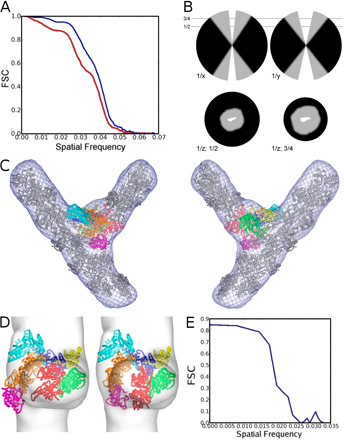
[View Larger Version of this Image]
Figure S1. Indicators of reconstruction quality. (A and B) Quality indicators for reconstruction of the branch junction formed by the A. castellanii Arp2/3 complex. (A) Fourier shell correlation (FSC) versus spatial frequency (1/Ǻ). The blue line is calculated in the traditional way by dividing the dataset after alignment to the same reference into two; the red line is calculated using one half aligned to one reference and the second half aligned to a different reference. The 0.5 cutoff criterion indicates a resolution of ∼2.5 nm and ∼2.7 nm, respectively. (B) Data coverage of the reconstruction. The top row shows two central slices through Fourier space along 1/x and 1/y. The bottom row shows slices at heights 1/2 and 3/4 (as indicated in top row) along 1/z. Black areas indicate >10 contributing motifs; gray areas indicate 1–10 contributing motifs. (C–E) Averaged reconstruction of frozen-hydrated branch junctions formed by the A. castellanii Arp2/3 complex with the docked branch junction model from fitting crystal structures into the reconstruction of negatively stained branch junctions. The correlation between the model and the density is 0.89, and the correlation with the reconstruction of the negatively stained Arp2/3 complex is 0.87. The color coding of the Arp2/3 complex subunits follows Fig. 2 of the main text. (C) Two views related by a 180° rotation. These views correspond to those shown in Fig. 2. Color coding also follows Fig. 2. (D) View from the daughter filament. (left) Best fit of the unmodified crystal structure into the density from the reconstruction of frozen-hydrated samples. The need for conformational changes in the ARP3/ARPC3 region (orange and magenta) is clearly visible. (right) Fit of the modified model into the density. (E) Fourier shell correlation versus spatial frequency (1/Ǻ).